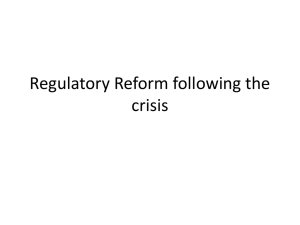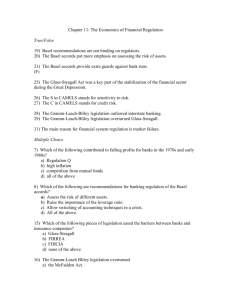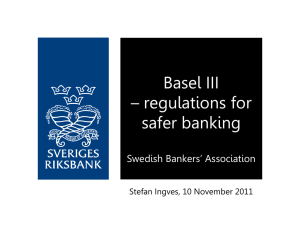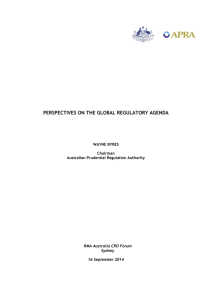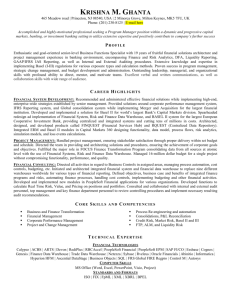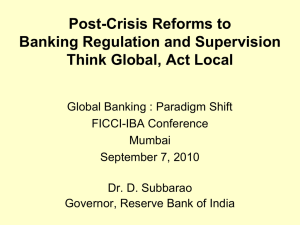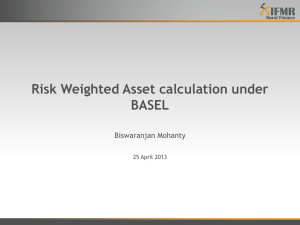Basel III and Indian Banking System
advertisement
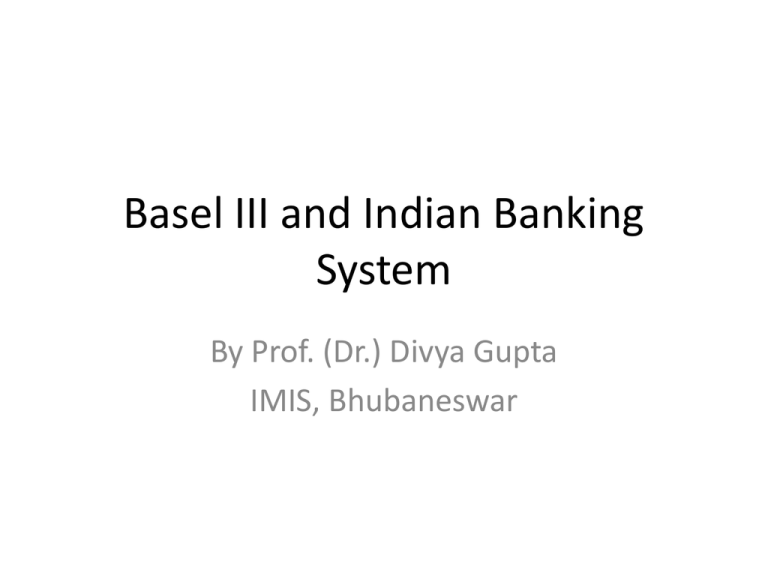
Basel III and Indian Banking System By Prof. (Dr.) Divya Gupta IMIS, Bhubaneswar Evolution of the Reform • BCBS is a committee formed by BIS to look into the adequacy of capital of banks with international presence. And the most far reaching of these initiatives was the laying down of minimum capital standards in 1988, known as Basel Capital accord. Basel I, II and III Basel I •In effect since 1988 •Very simple in application • India implemented in 1992 •“One-size-fits-all” approach • Concentrated only on “credit risk” Basel II •In effect since 2004 •More risk sensitive • India Implemented in 2009 •Did not impose additional capital requirement on banks •Did not consider liquidity risk as part of capital regulation. Basel III • In effect from 2013 to 2019 •Addresses perceived shortcomings of Basel II •Greatest impact on trading book, bank liquidity and bank leverage • Will increase capital charges materially and make certain banking activities much more capital intensive Hierarchy of Financial Risks Equity Risk Market Risk Financial Risks Interest Rate Risk Currency Risk Credit Risk Commodity Risk Operational Risk Transaction Risk Portfolio Concentration Risk Basel III Objectives of Basel III • To strengthen global capital and liquidity regulations with the goal of promoting a more resilient banking sector. • To improve the banking sector's ability to absorb shocks arising from financial and economic stress Type of Capital • Tier I capital is capital that is available to absorb losses on a "goingconcern" basis, or capital that can be depleted without placing the bank into insolvency, administration or liquidation. • Tier II capital is capital that can absorb losses on a "gone-concern" basis or capital that absorbs losses in insolvency prior to depositors losing any money. Key Principles Capital Requirements • Increase in capital • Introduction of Capital conservation buffer • Introduction of Counter-cyclical buffer Key principles Leverage Ratios • The banks are expected to maintain a leverage ratio in excess of 3% under Basel III. Key Principles Liquidity requirement Basel III introduced two required liquidity ratios. • "Liquidity Coverage Ratio" is supposed to require a bank to hold sufficient high-quality liquid assets to cover its total net cash outflows over 30 days. • “Net Stable Funding Ratio” is to require the available amount of stable funding to exceed the required amount of stable funding over a oneyear period of extended stress. Basel III Summary of Reforms: • Increased overall capital requirement • Narrower definition of qualifying regulatory capital • Increased capital charges for banking book exposures • Increased capital charges for trading book exposures • New leverage ratio • Two new liquidity ratios Challenges & Impact • Additional CapitalMore capital -> less leverage to lend money and profitability -> Increase in lending rates. • Pressure on ROE- As the upper limit for the leverage ratio by Basel III has been set at 3%, the value of the leverage multiplier will come down, resulting in a reduction in the ROE. • Pressure on yield on assets- On account of higher deployment of funds in liquid assets that give comparatively lower returns, banks' yield on assets, and thereby their profit margins, may be under pressure. • Capital conservative buffer- There is a trade-off for banks between being prudent and increasing profit. • Implementing the countercyclical capital buffer- A critical component of the Basel III package is implementation of countercyclical capital buffer which mandates that banks build up a higher level of capital in good times. Challenges & Impact • Frequent regulatory reports - Cost will be high. • Change in business mix- more focus on retail banking which has a comparatively lower risk weight compared to corporate banking. • Improvement in systems and procedures- Refining the rating model/data cleaning/ modernisation of systems and procedures may help banks economise their riskweighted assets. Initiatives • Lowering of Government stake in public sector banks. • Non-equity regulatory capital instruments by banks under the stringent Basel III framework under which lenders can issue tier 2 capital with a minimum original maturity of 5 years as against 10 years now. • Reserve Bank of India (RBI) has added an extra year to the transitional period for local banks to meet Basel III capital requirements. Initiatives • The RBI proposal to create a holding company for Public sector banks to which the equity of state-owned banks can be transferred. This is being seen as first step to effect much-needed structural changes in the banking sector of the country. Thank You!!!


